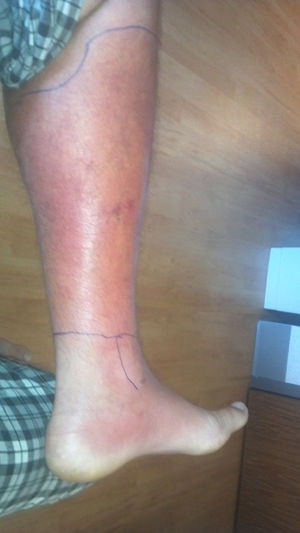We need you! Join our contributor community and become a WikEM editor through our open and transparent promotion process.
Cellulitis
From WikEM
Contents
Background
- Acute spreading infection of the dermis and subcutanous tissue, causing overlying skin inflammation[1]
- Most often caused by streptococcus or staphylococcus (including MRSA)
Clinical Features
- Rash
- Local erythema, warmth, swelling
- Tender indistinct margins
- Can be accompanied by fever, chills, malaise, headache, nausea/vomiting
Differential Diagnosis
Skin and Soft Tissue Infection
Look-A-Likes
Hand and finger infections
- Bedbugs
- Closed fist infection (Fight Bite)
- Hand cellulitis
- Hand deep space infection
- Herpetic whitlow
- Felon
- Flexor tenosynovitis
- Paronychia
- Scabies
- Sporotrichosis
Evaluation
Work-up
- Ultrasound can be helpful to rule-out abscess
Evaluation
- Generally clinical diagnosis, may be assisted by ultrasound (above)
Management
Antibiotics
Tailor antibiotics by regional antibiogram[2]
Outpatient
Coverage primarily for Strep
MRSA coverage only necessary if cellulitis associated with: purulence, penetrating trauma, known MRSA colonization, IV drug use, or SIRS[3]
- 5 day treatment duration, unless symptoms do not improve within that timeframe[3]
- Cephalexin 500mg PO q6hrs OR
- Clindamycin 450mg PO TID
- Tetracyclines (like Doxycycline) should be avoided in non-purulent cellulitis, due to high rates of Strep resistance[6]
Inpatient
- Vancomycin 20mg/kg IV q12hrs OR
- Clindamycin 600mg IV q8hrs OR
- Linezolid 600mg IV q12hrs OR
- Daptomycin 4mg/kg IV once daily
coverage extended for Vibrio vulnificus
- Doxycycline 100mg PO/IV q12hrs daily + Cefepime 1g IV q12hrs x 10 days
- Ciprofloxacin 400mg IV q12hrs x 10 days
- Ciprofloxacin 750mg PO q12hrs x 10 days
coverage extended for Aeromonas sp
- Ciprofloxacin 400mg IV q12hrs x 10 days
- Ciprofloxacin 500mg PO q12hrs x 10 days
- TMP/SMX 2 DS tablets (5mg/kg) PO q12hrs x 10 days
- Ceftriaxone 1g (50mg/kg) IV q24hrs
Predictors of Treatment Failure[7]
- Fever (T>38°C) at triage (odds ratio [OR] 4.3)
- Chronic leg ulcers (OR 2.5)
- Chronic edema or lymphedema (OR 2.5)
- Prior cellulitis in the same area (OR 2.1)
- Cellulitis at a wound site (OR 1.9)
Disposition
- Admit for:
- Sepsis
- Significant hand, face, or genitalia infection
- Failure of outpatient treatment
- Significant comorbidity (e.g. immunocompromized, poorly controlled diabetes)
See Also
References
- ↑ Gunderson CG, Martinello RA. A systematic review of bacteremias in cellulitis and erysipelas. J Infect. 2012 Feb;64(2):148-55.
- ↑ Stevens D, et al. Practice guidelines for the diagnosis and management of skin and soft tissue infections: 2014 update by the Infectious Diseases Society of America. Clin Infect Dis. 2014;59(2):e10-e52
- ↑ 3.0 3.1 Stevens D, et al. Practice guidelines for the diagnosis and management of skin and soft tissue infections: 2014 update by the Infectious Diseases Society of America. Clin Infect Dis. 2014;59(2):e10-e52
- ↑ Cadena J, et al. Dose of trimethoprim-sulfamethoxazole to treat skin and skin structure infections caused by methicillin-resistant Staphylococcus aureus. Antimicrobial agents and chemotherapy 55.12 (2011): 5430-5432.
- ↑ Pallin D, et al. Clinical trial: comparative effectiveness of cephalexin plus trimethoprim-sulfamethoxazole versus cephalexin alone for treatment of uncomplicated cellulitis: a randomized controlled trial. Clinical infectious diseases 56.12 (2013): 1754-1762
- ↑ Traub, W and Leonhard, B. Comparative susceptibility of clinical group A, B, C, F, and G beta-hemolytic streptococcal isolates to 24 antimicrobial drugs. Chemotherapy 43.1 (1997):10-20.
- ↑ Peterson D. et al. Predictors of failure of empiric outpatient antibiotic therapy in emergency department patients with uncomplicated cellulitis. Acad Emerg Med. 2014 May;21(5):526-31.

